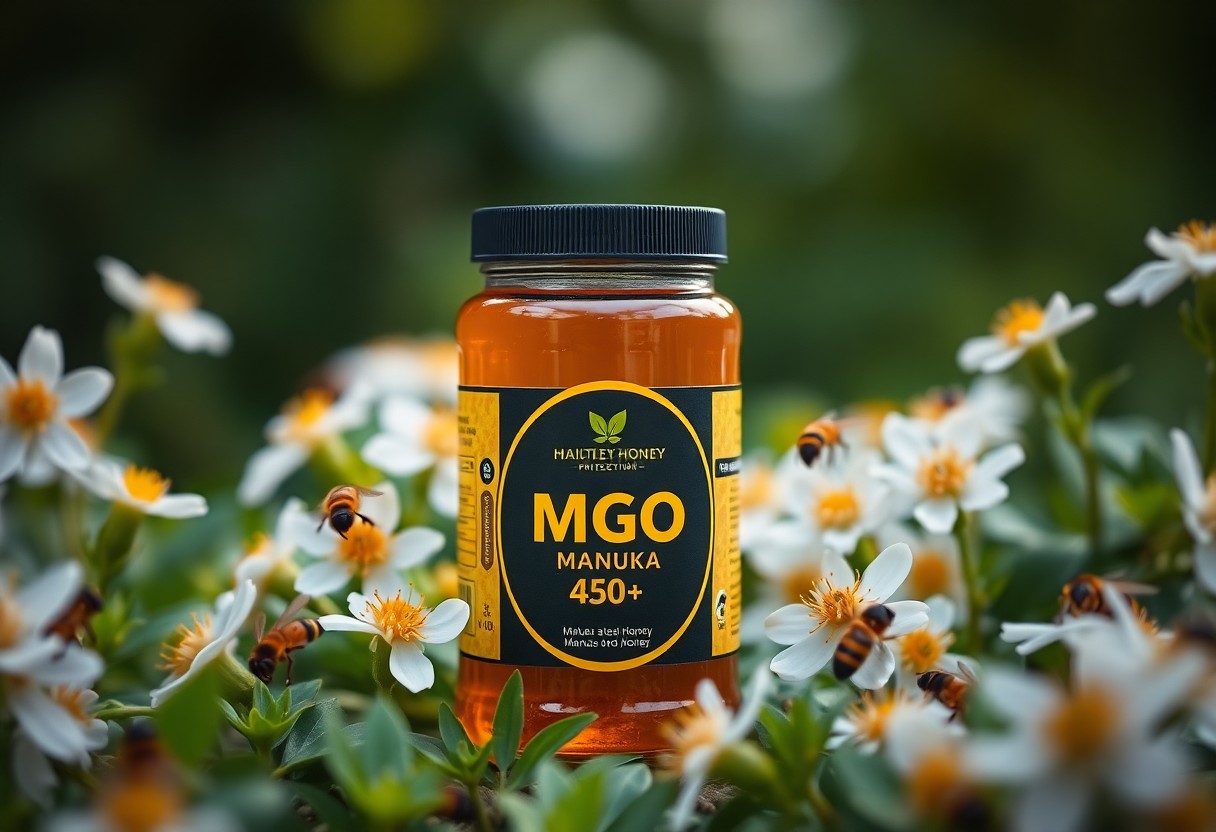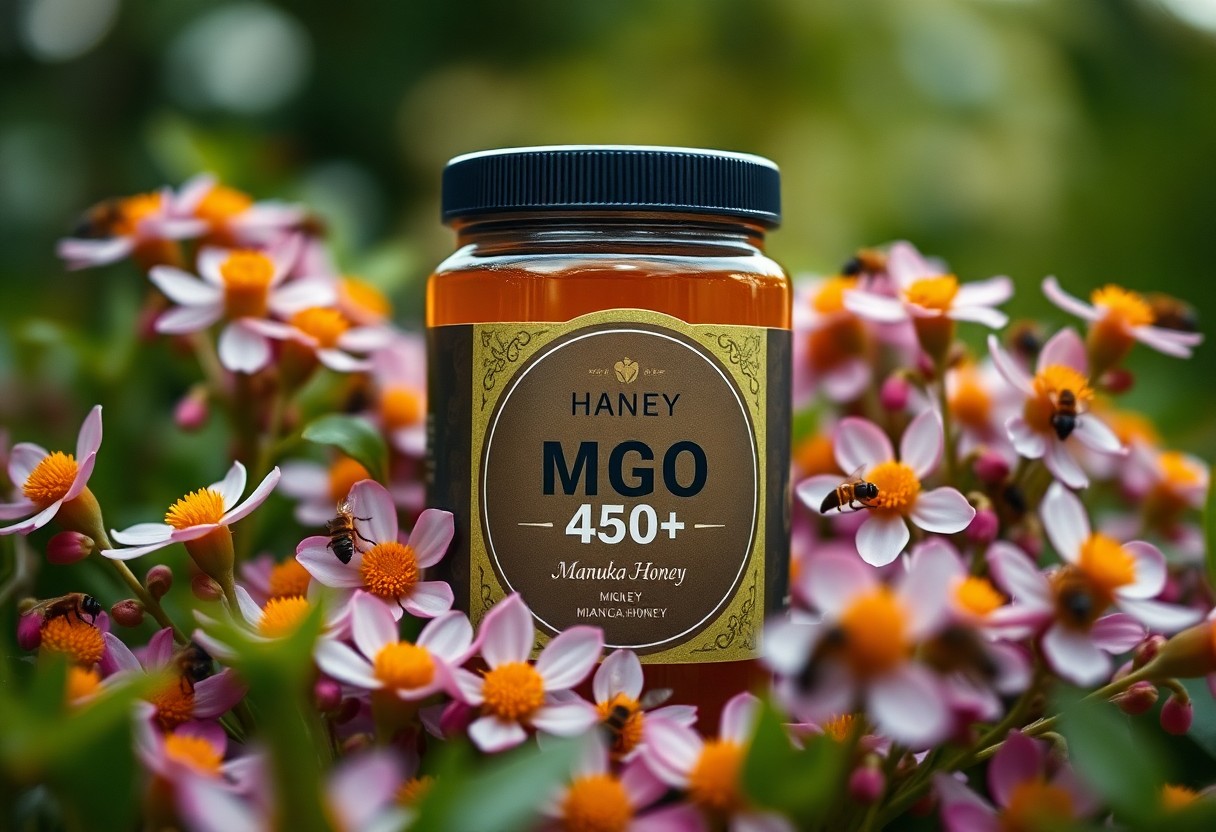Manuka honey is not just a sweet treat; it boasts incredible health benefits that set it apart from regular honey. You may be interested to learn that Manuka honey with MGO 450+ contains a high concentration of methylglyoxal, a compound linked to numerous positive effects on health, including potential antibacterial properties. Its unique properties have led researchers to uncover why this honey can be a powerful natural remedy. In this post, you’ll explore the reasons behind these remarkable qualities and how incorporating Manuka honey into your routine could enhance your well-being.
Understanding Manuka Honey
For those curious about Manuka honey, it is a unique variety that originates from the nectar of the Manuka tree, native to New Zealand and Australia. Praised for its potential health benefits, this honey stands out due to its high concentration of methylglyoxal (MGO), which contributes significantly to its remarkable properties.
Definition and Origin
Definition: Manuka honey is a specialty honey made from the nectar of the Manuka tree, Leptospermum scoparium. This tree flourishes in the wild across New Zealand and some parts of Australia. Known for its distinctive flavor and potential therapeutic properties, Manuka honey has become increasingly popular worldwide.
Key Differences from Regular Honey
Regular honey often lacks the unique compounds found in Manuka honey, making it less effective for health benefits. While regular honey may offer basic nutritional value, it does not contain the high levels of methylglyoxal (MGO) that provide Manuka honey its renowned therapeutic properties.
Plus, Manuka honey’s strength is measured by its MGO rating, with higher ratings indicating greater potency. Unlike regular honey, which mainly offers general sweetness and some antioxidants, Manuka honey’s benefits are linked to its antibacterial and anti-inflammatory effects. This makes it a preferred choice for those seeking natural remedies for various ailments, however, it’s important to select products with verified MGO levels for authenticity and effectiveness.
The Science of MGO
If you’re curious about the remarkable properties of Manuka honey, understanding MGO, or methylglyoxal, is vital. This compound contributes significantly to the honey’s unique benefits, making it sought after for its antimicrobial properties. To dive deeper into this fascinating subject, check out What is MGO in Manuka honey? Methylglyoxal explained.
What is Methylglyoxal (MGO)?
For many honey enthusiasts, MGO is a term often associated with the therapeutic benefits of Manuka honey. It is a naturally occurring compound that contributes to the honey’s distinctive flavor and health properties, offering robust antimicrobial effects that can enhance overall well-being.
MGO Concentration in Manuka Honey
Below, you’ll find that MGO concentration can vary significantly among different Manuka honey products. This variance is often reflected in the honey’s grading system, where higher MGO levels indicate greater therapeutic potential, making it a valuable asset in your wellness toolkit.
Methylglyoxal plays a significant role in the effectiveness of Manuka honey, with concentrations typically ranging from 30 to over 1,000 mg/kg. Higher MGO levels are linked to stronger antimicrobial properties, providing benefits that may support your immune system and overall health. Opting for honey with at least MGO 450+ ensures you harness the full potential of this remarkable natural product.

Unique Properties of Manuka Honey
Any health-conscious individual is likely to be intrigued by the unique properties of Manuka honey. Sourced from the nectar of the Manuka tree in New Zealand, this distinct honey is more than just a sweetener. It possesses a wealth of beneficial properties, making it a sought-after natural remedy. MGO 450+ indicates its high methylglyoxal content, which is responsible for its enhanced therapeutic qualities. When you incorporate this honey into your diet or skincare regimen, you may experience its extraordinary benefits for both your health and well-being.
Antibacterial and Antifungal Effects
Beside its delightful taste, Manuka honey is renowned for its potent antibacterial and antifungal effects. The unique combination of natural compounds in this honey makes it effective against various pathogens, providing a protective barrier against infections. When you apply it topically or consume it, the powerful properties work synergistically to defend your body from harmful microorganisms, ensuring your immune system remains resilient.
Anti-Inflammatory and Healing Properties
Anti-inflammatory properties are another remarkable aspect of Manuka honey that you should consider. When applied to wounds or consumed, it helps to reduce inflammation, thus promoting faster healing. This natural remedy not only aids in soothing irritated skin but also supports overall recovery from minor ailments. Its unique composition encourages tissue regeneration, making it an excellent choice for your first aid kit.
This remarkable honey can significantly enhance your health and wellness due to its anti-inflammatory and healing properties. As you apply it to cuts or burns, Manuka honey forms a protective layer that aids in reducing swelling and preventing infection. Moreover, the high levels of antioxidants present in Manuka honey work to neutralize free radicals, further promoting healing. You will find that incorporating this honey into your daily routine can support your body’s innate ability to recover, making it a valuable addition to your natural health arsenal.
Health Benefits of MGO 450+ Manuka Honey
To experience the myriad health benefits of MGO 450+ Manuka honey, you can integrate it into your daily routine. This potent honey is packed with unique antibacterial and anti-inflammatory properties, making it a popular choice for those seeking natural remedies. Regular consumption can help promote overall well-being, supporting your health in various ways.
Immune System Support
Benefits of MGO 450+ Manuka honey for your immune system are plentiful. This remarkable honey contains compounds that can effectively enhance your body’s natural defenses, helping you to ward off infections and illnesses, particularly during flu season or periods of stress.
Skin Care and Wound Healing
Healing with MGO 450+ Manuka honey can significantly improve your skin health and aid in wound recovery. Its unique attributes make it an excellent natural remedy for minor cuts, burns, and acne. The honey’s natural antibacterial properties can reduce the risk of infection while promoting faster healing and reducing inflammation.
The effectiveness of MGO 450+ Manuka honey in skin care and wound healing is attributed to its high levels of methylglyoxal, which provides potent antibacterial action. When applied topically, it creates a protective barrier and facilitates an optimal environment for skin repair. Many users find it beneficial for dry skin, eczema, and even psoriasis. Applying this honey can soothe irritation while its natural humectant properties draw moisture to the skin, ensuring your skin remains hydrated and rejuvenated.
Quality and Authenticity of Manuka Honey
All Manuka honey is not created equal. To ensure you are purchasing a high-quality product, it is necessary to understand the factors that determine its authenticity. Genuine Manuka honey originates from the nectar of the Leptospermum tree, primarily found in New Zealand and parts of Australia. Look for certifications and grading systems that indicate the honey’s purity and unique properties, which will help you make an informed choice.
Certification and Grading Systems
Beside research and recommendations, reliable certification and grading systems are fundamental in distinguishing authentic Manuka honey. The Unique Manuka Factor (UMF) and Methylglyoxal (MGO) ratings are two of the most recognized systems. A higher UMF or MGO rating signifies stronger antibacterial properties, offering you confidence that you are investing in a product that aligns with health benefits.
Recognizing Genuine Manuka Honey
Before purchasing Manuka honey, you should be well-versed in how to identify genuine products. Look for clear labels, QR codes, or certifications from recognized organizations that vouch for the honey’s source and testing. Such labels can provide reassurance that you are consuming what you expect.
Hence, to effectively recognize genuine Manuka honey, always check for the UMF or MGO rating on the jar. Beware of products that lack these certifications, as they may be diluted or fake. When shopping, you should also consider the origin; authentic Manuka honey must come from New Zealand or Australia, ensuring that it retains its distinctive properties. Make a habit of reading the label thoroughly, and don’t hesitate to reach out to sellers for additional information regarding quality controls. Your health will benefit from knowing you have chosen the best.

Culinary Uses of Manuka Honey
Despite its renowned health benefits, Manuka honey also shines in the culinary world. It adds a distinct flavor and nutritional value to a variety of dishes, making it a versatile ingredient in your kitchen. Whether you use it as a sweetener or a finishing touch, Manuka honey elevates your meals while providing unique properties that go beyond regular honey.
Incorporating in Recipes
Manuka honey can be seamlessly integrated into a wide range of recipes. You can use it in salad dressings, marinades, or drizzled over yogurt and oatmeal for an extra layer of flavor and health benefits. Its robust taste makes it a perfect choice for desserts as well, adding a natural sweetness without any artificial ingredients.
Pairing with Other Ingredients
Manuka honey pairs well with a variety of ingredients to enhance flavors and health benefits. It complements fruits like apples and berries, as well as savory elements such as cheese and grilled meats. This honey also harmonizes with herbs and spices, making it a fantastic addition to both sweet and savory dishes.
Understanding how to pair Manuka honey with other ingredients can unlock a world of culinary possibilities. When mixed with citrus fruits, it balances acidity while adding a touch of sweetness. For savory applications, try combining it with rosemary or thyme to create a unique glaze for meats. Additionally, when drizzled over hard cheeses, the contrast creates a delightful appetizer that’s both sophisticated and simple. The potential is vast, allowing you to experiment and discover new flavor profiles that enhance your meals.
Final Words
Conclusively, understanding the unique properties of Manuka honey MGO 450+ allows you to appreciate its significant health benefits. By harnessing the science behind its high methylglyoxal content, you can make informed choices about incorporating this remarkable natural product into your wellness routine. Whether you’re using it for its antibacterial properties or as a soothing ingredient, Manuka honey is a versatile addition that can enhance your overall well-being. Embrace the power of nature’s hive and enjoy the advantages that Manuka honey brings to your life.
Q: What is Manuka honey and what makes MGO 450+ special?
A: Manuka honey is a unique type of honey produced by bees that pollinate the Manuka tree, native to New Zealand and parts of Australia. The designation MGO 450+ indicates that this honey contains a minimum of 450 mg of methylglyoxal (MGO) per kg, which is a compound known for its potent antibacterial properties. This high level of MGO is what sets MGO 450+ Manuka honey apart from other types of honey, as it offers enhanced health benefits, including wound healing, aiding digestion, and boosting the immune system.
Q: How should I use Manuka honey MGO 450+ for health benefits?
A: Manuka honey MGO 450+ can be used in various ways to harness its health benefits. You can consume it directly by taking a teaspoon daily, or add it to warm water, herbal teas, or smoothies. It can also be applied topically to minor cuts or burns to promote healing due to its antibacterial properties. However, it’s advised to avoid cooking with Manuka honey at high temperatures, as this can diminish its beneficial compounds. Always consult with a healthcare professional if you have specific health conditions or dietary concerns.
Q: Are there any certifications or standards to look for when purchasing MGO 450+ Manuka honey?
A: Yes, when purchasing MGO 450+ Manuka honey, it is important to look for certification labels that indicate the honey has been tested for its MGO content. Reputable brands usually display the MGO rating prominently on the product label. Additionally, certifications from recognized organizations like the Unique Manuka Factor Honey Association (UMFHA) or the New Zealand Ministry for Primary Industries can provide assurance of authenticity. Always choose products from trusted brands to ensure that you are getting high-quality Manuka honey that meets the stated specifications.


